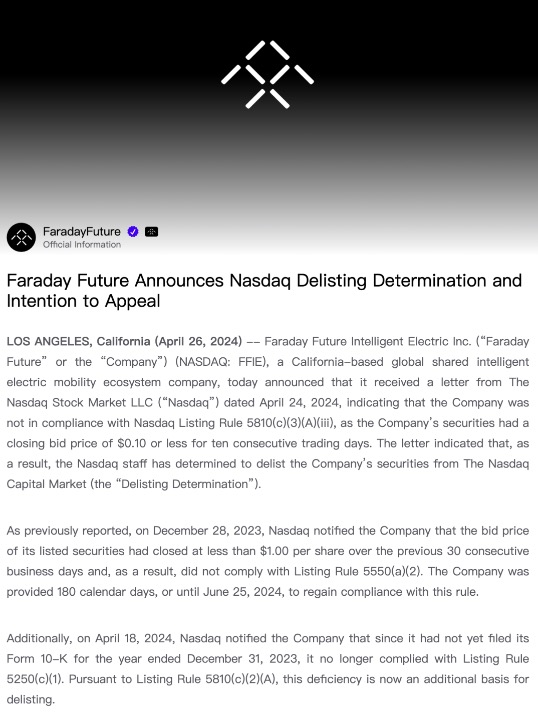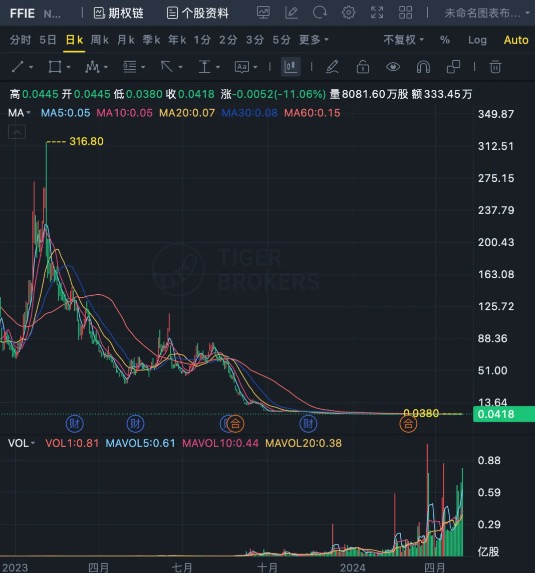On April 30th, Faraday Future (Faraday Future, referred to as FF) released a notice on its official website. The company received a letter from the Nasdaq exchange, because the closing buy-in price of the company’s stock for ten consecutive trading days was 0.10 US dollars or less, and the Nasdaq exchange decided to delist the company from the capital market.

In response, Faraday Future stated that the company intends to request a hearing before May 1, 2024 (the latest allowed date) to appeal the “Delisting Ruling.” This decision will suspend the stock suspension for 15 days, and the company’s securities will continue to be listed on the Nasdaq capital market from the date of the request. In fact, Faraday Future has been warned of delisting many times.
The ups and downs of the road to building cars directly affect Faraday Future’s situation in the capital market. On July 22, 2021, FF was listed on the Nasdaq in the United States through a shell listing, and started officially trading under the stock code “FFIE”. The issue price of FFIE was 13.78 US dollars, with a closing increase of 1.45% on the first day, and a closing price of 13.98 US dollars, with a total market value of 4.535 billion US dollars. However, due to the repeated delays in mass production and delivery, coupled with the continuous faced funding problems of the FF company, the FF stock price eventually closed continuously below 1 US dollar, and received a delisting warning from the Nasdaq.
On October 31, 2022, Faraday Future received a notice from Nasdaq, stating that its stock did not meet the provisions of Rule 5550 (A) (2) of the Nasdaq listing rules, that is, the stock price must be higher than 1 US dollar for 30 consecutive trading days. This notice has no immediate impact on the common stock of Faraday Future being listed on the Nasdaq, and the company has 180 days to become compliant again.
In order to ensure compliance, Faraday Future’s approach is a “reverse stock split”, that is, by reducing the share capital to increase the net value of the stock unit. In August 2023, Faraday Future announced that at a special shareholders’ meeting, a proposal approved by the shareholders was to authorize the board of directors of the company to perform a reverse stock split on the common shares already issued by the company, with the implementation ratio ranging between 1:2 and 1:90. If the stock consolidation is implemented, the number of common shares authorized but not yet issued will increase. Before this, the stock price of Faraday Future has been consistently below 1 US dollar, far below the listing standards of the Nasdaq trading. After the stock consolidation, the stock price of Faraday Future returned to above 1 US dollar, but the stock price still continued to fall afterwards. It is understood that after the stock consolidation, the stock price of Faraday Future was 22.00 US dollars, but in just 30 trading days, the stock price plunged by 95%, once again falling below 1 US dollar.
According to the Nasdaq delisting regulations, when the stock price of a listed company is lower than 1 US dollar for 30 consecutive trading days, it meets the delisting standards. As early as December 28, 2023, the Nasdaq exchange had already notified the company that the buying price of its listed securities had been lower than 1.00 US dollar for the consecutive closing price of 30 business days in the past, which did not meet the provisions of Rule 5550 (a) (2), but Faraday Future had 180 days until June 25, 2024, to re-comply with the listing rules, otherwise it will be forced to delist. As of the closing on April 29, 2024, the stock price of Faraday Future was quoted at 0.0418 US dollars, with a total market value of only 1.7837 million US dollars, setting a new low closing price since its IPO on the Nasdaq.

In other words, today (April 30) is the last day for Faraday Future to be traded and listed in the capital market, and it will be suspended for 15 days from May 1. If Faraday Future cannot bring the stock price back to 1 US dollar before June 25, 2024, it will eventually be forced to delist.
In 2023, Faraday Future delivered a total of 11 FF 91s throughout the year. In March, Faraday Future recalled 11 FF 91 2.0 delivered in 2023 to the NHTSA. The reason for the recall is that when the airbag control unit (ACU) detects a system failure, a software error may prevent the airbag failure warning light from coming on, and the driver will not be warned of the ACU loss of communication failure. If the airbag pops out correctly during a collision, it may increase the risk of occupant injury. In response to these defects, Faraday Future will update the iHUB module software through OTA upgrades.

Although FF has been produced and delivered, at the current delivery speed, it will take a long time to achieve a break-even balance. In addition, currently, FF still lacks money. Therefore, if FF wants to carry out a new round of deliveries, it still needs to rely on financing to complete it, and how much money FF needs to solve the delivery problem is currently not clear to the outside world, nor is it certain whether Faraday Future will still have prospects.


